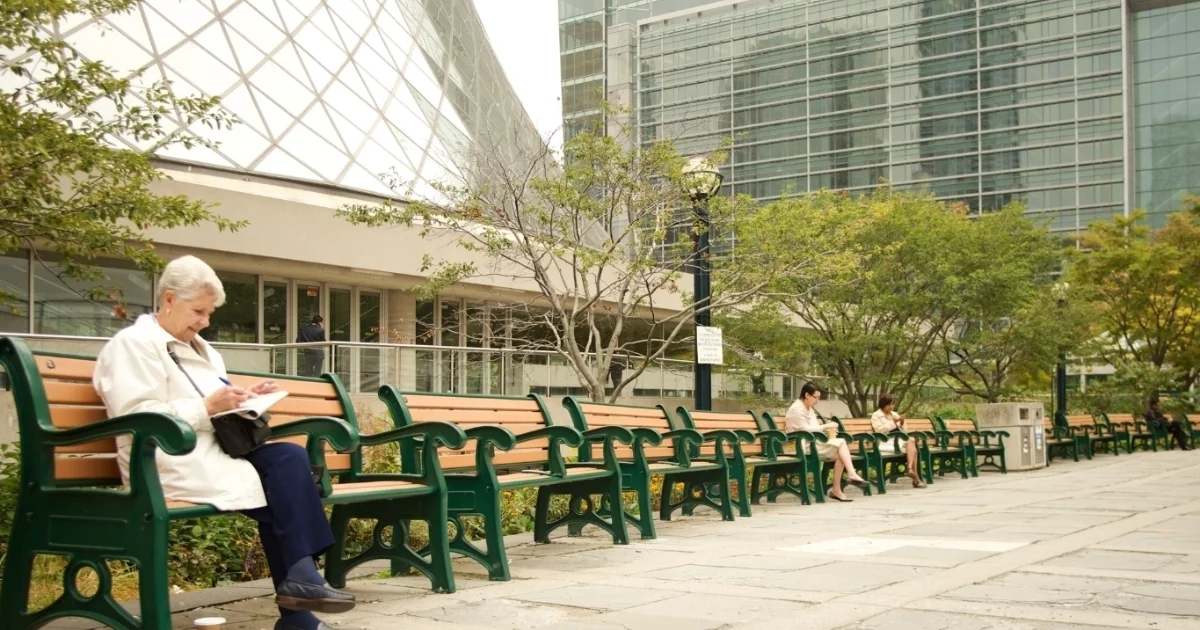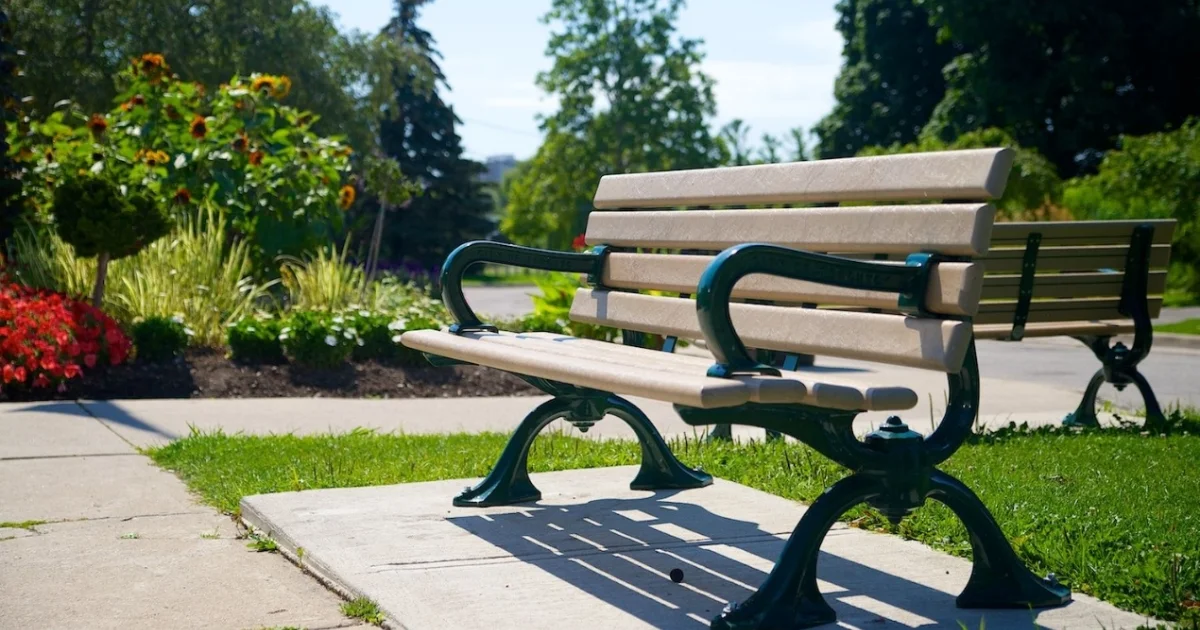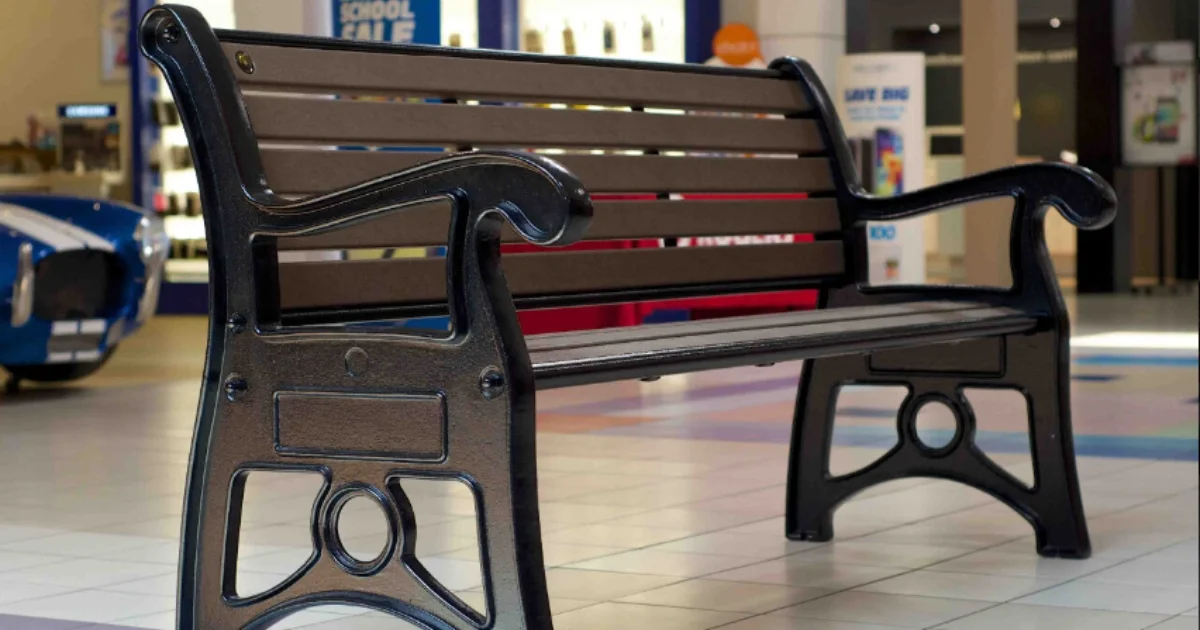
When creating inclusive public spaces, accessibility must be at the top of mind. It's more important than ever to ensure everyone can access outdoor green spaces, as environmental sustainability and physical/mental health are important for people of all abilities. A part of making outdoor green spaces accessible is having reliable site furniture – including public benches.
But do your benches meet the standards set by the Accessibility for Ontarians with Disabilities Act (AODA) and other guidelines? If you're not sure, you should keep reading.
These guidelines are designed to address a diverse range of users, including people with mobility issues, seniors, and parents using strollers. You want everyone to feel they can interact with their community safely and accessibly, so if you're wondering if your benches meet the mark, you need to explore a few key requirements to make sure they're compliant.
The AODA was established in 2005 with the main goal of making Ontario a fully accessible province by the year 2025. The legislation outlines the guidelines for all public spaces, including seating, to make sure they're barrier-free for those who have physical limitations.
According to the AODA, there is a list of requirements for rest areas with benches/seats along accessible routes – detailing that there should be a bench or seat every thirty metres in a designated rest area. These standards also provide height ranges for benches/seats.
In areas with more than 1 seat, some should have backrests.
Other seats should have armrests.
Some seats should have both.
Surfaces below benches/seats need to be sturdy and level.
The nearby space also needs to be sturdy and level to support people's assistive devices, children's strollers, and service animals.
The nearby space needs to have a good colour contrast to be easily identifiable.
Furthermore, the national accessibility standards in both Canada and the US, such as the Canadian Standards Association (CSA) and the Americans with Disabilities Act (ADA), offer a clear framework for inclusive designs.
The main goal of these standards is to ensure environments where those with physical limitations can comfortably and safely navigate public spaces. When it comes to benches, what truly makes a thoughtful design includes elements such as seat height, armrests, backrests, and overall proximity to accessible pathways.
Now that we've gone over the AODA guidelines for accessibility, it's time to go a little deeper into what makes your bench disability accessible. This can help you make the right choice when choosing public benches for outdoor green spaces.
Appropriately accessible benches need to have a seat height that allows individuals with mobility devices or limited movement to sit and stand up comfortably and safely. Generally speaking, a height between 43.18 cm (17”) - 48.26 cm (19”) from the ground is recommended.
Listen - armrests aren't just a design choice. They're essential for many people who need support transitioning from sitting to standing positions. They're also excellent visual markers for individuals who have vision impairments.
Backrests, while a common design element of benches, have the added benefit of providing essential support for users – particularly, seniors and people with chronic conditions. For a bench to be accessible, they must have sturdy backrests at least 30.48 cm (12") above the seat base.
Benches need to be placed along accessible pathways and provide sufficient space for wheelchairs and mobility scooters to manoeuvre around safely. There must be about 91.44 cm (36") around the bench to allow for proper clearance.
You need to make sure that the materials in the bench's design are slip-resistant to ensure no unfortunate accidents occur. This is essential in outdoor settings where rain and snow can cause potentially dangerous conditions.
To make benches more visible, they need to have higher contrasting colours to make them easier for those with visual impairments to spot. This doesn't mean they need to be neon colours (although, you can do that if you like!), but for example: a light-coloured bench against a darker background can help users identify seating areas quickly. In contrast, a darker bench in a more open, bright area could be easier to see.
See our Accessible Riverside Bench as a good example of a compliant bench.

OK, we’ve given you a lot of information so far! We understand that these issues can be a little overwhelming, so why don’t we get back to the human element of this entire thing? Exploring why compliance truly matters: outside of the obvious of following regulations, compliance for accessible site furniture is important for the community at large. Making outdoor green spaces accessible ensures the health, happiness, and safety of everyone in your community, from the physically limited to the elderly, or even just parents pushing strollers. Let’s get further into why compliance truly matters:
Accessible benches create a welcoming space for everyone, not just the people who need them. When public spaces cater to a diverse set of needs, even people without disabilities or limitations can benefit from accessible site furniture. Accessibility allows everyone to interact with benches and site furniture safely and conveniently. This encourages a greater community connection and inclusivity.
Outside of the moral obligation, it is the law to follow AODA requirements. Being non-compliant in some circumstances could result in legal penalties and damage to your organization's reputation. Making sure that your public benches meet the requirements helps protect you and others.
Accessible benches, as we've mentioned, are easier for everyone to use. Not just people with disabilities, but also the elderly, pregnant women, and even parents with young kids. By including accessibility in your design, you improve usability for a larger community.
The population is ageing – meaning the demand for accessible infrastructure is going to only increase in the future. By investing in accessible benches and other site furniture, you're ensuring your public spaces remain relevant and functional in the future, putting you ahead of the curve!
Check out our Accessible Heritage Bench for more options!

You know the standards and best practices, as well as the reason why all of this is important… but what common mistakes happen when it comes to choosing a bench design and placement? These mistakes might be easier to make than you think, so let’s explore some potential pitfalls to avoid.
We understand that sometimes you want a sleek and sophisticated design. That’s why benches without armrests are sometimes quite desirable because they offer that modern look. However, a lack of armrests can be detrimental to those who need them to safely support themselves and transition from sitting to standing. So, if accessibility is your desire, you want to opt for something with armrests.
You need to avoid placing benches too close to walls or obstructed pathways, as it limits access for individuals with mobility devices. You also want to make sure the surrounding area is thoroughly cleaned and maintained, avoiding excessive litter and environmental debris (fallen branches, dead plants, rocks, and stones) is essential to ensuring the health and safety of the community.
You need to avoid placing benches on uneven ground or too far from accessible pathways, otherwise, they fail to serve their designed purpose – to be a rest spot for EVERYONE. You need to carefully consider and strategically place benches in areas that are safe and secure.
These days, benches are designed with recycled and durable materials designed to stand the test of time. Nonetheless, accessibility doesn't stop after you install the bench – you still need to keep an eye on it and make sure regular maintenance is conducted on the furniture and surrounding area.
Whew! That was a big one, thanks for sticking around and learning more about the importance of compliance with AODA when it comes to accessible benches. Before we conclude, let’s quickly go through a few tips to ensure your benches are compliant:
Conduct an Accessibility Audit: Assess your current benches and ensure they meet AODA and national accessibility standards and document areas of improvement.
Choose the Right Materials: Make sure you opt for durable and slip-resistant materials that perform well in the local climate. You can also consider sustainable options (such as benches made from recycled materials) for additional green benefits.
Partner with Accessible Suppliers: Classic Displays offers a variety of accessible options for all our site furniture. It’s important to collaborate with designers who specialize in providing accessible site furniture with additional options for customization.
At Classic Displays, we want to make sure everyone feels included. This is why we offer a range of accessible site furniture, from benches to trash and recycle bins, bike racks, and more. We work to create customized solutions to your site furniture needs, and can customize everything from armrests, backrests, material and the colour of your bench! With more than 46+ years of experience, you can trust we have your best interest at heart, and the best interest of your community.
Contact us today for more information about our accessible site furniture.